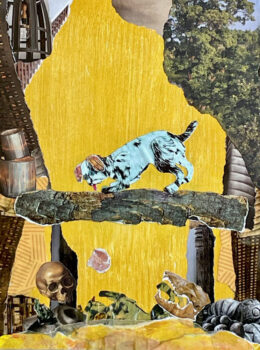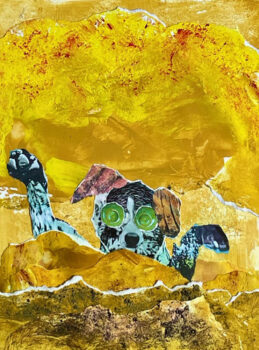The Dog and the Meat
Annelie van Steenbergen, text & illustrations
‘It happened that a dog had got a piece of meat in his mouth and, on his way home, walked across a plank with water underneath it.’
 This is the first sentence of a fable of only four sentences by the Greek narrator Aesop about a dog and a piece of meat [1]. It is a clear and concrete sentence, you can see it happening. Aesop told his moral stories long ago, between 620 and 560 BCE. The story he speaks of, must therefore have taken place somewhere far away in the ‘once upon a time’ era. In any case, a time when a dog could apparently easily get a nice piece of meat.
This is the first sentence of a fable of only four sentences by the Greek narrator Aesop about a dog and a piece of meat [1]. It is a clear and concrete sentence, you can see it happening. Aesop told his moral stories long ago, between 620 and 560 BCE. The story he speaks of, must therefore have taken place somewhere far away in the ‘once upon a time’ era. In any case, a time when a dog could apparently easily get a nice piece of meat.
Nowadays that would no longer be so easy. Where does a dog get a decent bone from? The meat, neatly cut ready-to-eat in the factory or by the butcher, is stored in the refrigerator and only brought out just before preparation. In addition, many people no longer eat meat, for environmental or animal-friendly reasons. About 20% of the world’s population is vegetarian, mainly born out of economic necessity, so a dog will not be able to just grab a chicken leg or a piece of shank meat.
In the past, there were of course no hygienic slaughterhouses with officially appointed inspectors. The butcher came to the farm and in earlier times, the cattle were simply slaughtered by the farmer himself for his own needs. The meat was smoked or dried for later use. The farmer’s wife made sausage and logs from the trimmings. You can imagine the farm dogs licking the blood from the floor and profiting from spilled leftovers of sheep or pig or beef.
Although people in ancient Greece mainly consumed grains, olive oil and wine, things would not have been very different in Aesop’s time. Especially during religious festivals, meat was eaten and the intestines were burned as a sacrifice to the gods. There was always some leftover for the dogs.
In this fable, Aesop talks about an even more distant past, ‘in the old days’. The meat was thrown to the dog, or perhaps he had stolen it, which is more likely, otherwise he would not have bothered to drag across the water. In any case, it is valuable loot Yet our dog is not careful enough with it. As soon as he walks across the plank, he sees a dog below him in the reflective water, with a huge piece of meat in its mouth. He cannot restrain himself, his desire for this apparently even bigger meal is too great. He opens his mouth to grab it and his own prey falls into the water with a splash. The mirrored dog has also lost its piece of meat.
As usual, Aesop ends this fable with a moral of the story:
“So it is with many others who, thinking they are berieving another from his property, often lose their own. After all, you shouldn’t give up what is certain for something that is uncertain.”
In the 17th century, the poet Jean de La Fontaine (1621–1695) used this fable by Aesop as an example of people who end up fooling themselves. In ‘The Dog that Gives up its Prey for the Shade’ [2] he writes:
‘Fools who for substance take its shadow
We find everwhere, nor is their number small.’
De La Fontaine’s story ends even worse, because the dog almost pays for his greed with his own life. He does not walk on a plank, like Aesop. He looks at the water from the steep bank and sees himself reflected in the stream. Oh, what a wonderfully tender piece of meat that other dog has in his mouth, he would like that one too. He drops his bone in the water and jumps towards its image. De La Fontaine writes that now the wind is rising, the water is waving, the current is getting stronger.
‘The dog, weary, slows his blows,
Half-dead, he reaches the edge of the shore,
But, lacy! without carrying prey or shadow.’
How unfortunate for Lacy! If only he had read Aesop. Yes, only IF…. Isn’t this often the case in our own lives
If we read this fable and think about what it can mean for ourselves, it can lead to dilemmas. Aesop’s moral is twofold. Those who covet other people’s property often lose their own. In other words, stolen goods do not thrive. However, the next sentence indicates something else:
‘After all, you shouldn’t give up what is certain for something that is uncertain.’
The word ‘after all’ does not condemn the act of stealing in itself. Stealing is frowned upon because the loot is uncertain.
The problem lies in the fact that our dog thought it was an actual piece of meat. If he had realized it was a reflection of himself, he would have made up his mind otherwise. Yes, if…
Is n’t this often the case in our own lives? How do you know that something is real and not a mirage? Because nothing is certain (and not even that), the philosophers would say. You make decisions based on the image you construct of reality, and the question is whether that subjective image is actually correct. De La Fontaine talks about self-deception and chasing a shadow. This means that we should try to be honest with ourselves and that we observe and inform ourselves carefully, so that we do as few stupid things as possible.
What if, instead of a virtual shadow, it had been a real dog with a real steak in its mouth? Much bigger and more delicious than his own bone? Would taking it away then be allowed? No, is the commandment. Don’t touch other people’s property, period. That too is a lesson from the fable storytellers
It happened that a dog had got a piece of meat in his mouth and is on his way home
He crosses a plank over a brook.
He sees his own shadow in the water and thinks:
‘The grass seems greener on the other side. We always want more. Be content with what you have!’
Should we just accept what we have and not strive for the better and (even) more? If you take that to the extreme, you end up like the Greek Diogenes of Sinope, who, according to legend, slept without possessions in a barrel in a dog cemetery. There wouldn’t be many people who would aspire to that. He was called ‘the royal dog’. There won’t be many people who would aspire that.
It may be useful to distinguish between the types of goods in this context. For example, the French sociologist Pierre Bourdieu distinguished three types of capital, namely economic, cultural and social. It makes a difference whether you pursue possessions in the form of money and goods or whether you want to acquire knowledge through, for example, diplomas, books or theater visits, or, whether you put energy into relationships and networks. Which way makes you happier?
In 1938 a study was begun that continues to this day [3], with the aim of finding out which factors contribute to a healthy and happy old age. In the study, white male students were asked what they wanted to achieve in their lives. Of those surveyed, 80% answered that they wanted to become rich and of those, 50% also wanted to become famous. They thought they could achieve this mainly through hard work.
After more than eighty years, …. the outcomes turned out differently than initially expected in that it was determined that it is not money or fame, but the warmth of relationships has the greatest positive influence throughout life. In other words, through social contacts and good relationships with family, friends and within the community, people live happier, physically healthier and longer lives.
Self-interest therefore dictates that we treat our fellow human beings with prudence and not attack them because of something we would like to possess ourselves. Here, we enter the realm of politics. This is how we move from a simple fable of four lines to a democratic debate about the distribution of goods.
To return to our dog, who, according to Aesop, gave up something certain for something uncertain: are you satisfied with life as it is, with enough food, a roof over your head and warm clothes? Or is it good to sometimes let go of something certain and pursue something of which you are uncertain in advance, whether you will succeed in achieving this? Such as a new job, a creative challenge or a sports achievement?
For everyone, the answer will require an individual search and a personal decision. Though what is beyond dispute is that regardless of the outcome, reading and contemplating fables is enjoyable and educational.
Noten
[1] Het leven en de fabels van Esopus. Teksteditie met inleiding, hertaling en commentaar door Hans Rijns en Willem van Bentum. Hilversum: Verloren, 2016, pp. 167-169.
[2] Jean de La Fontaine (nagevolgd door J.J.L. ten Kate) – De fabelen van La Fontaine. Amsterdam: Gebroeders Binger, 1875 (?) (1e druk). Geïllustreerd met platen en vignetten door Gustave Doré. Fabel XVII, zesde boek, pp. 378-379.
[3] Harvard Study of Adult Development (adultdevelopmentstudy.org). TED Robert Waldinger: What makes a good life? Lessons from the longest study on happiness (2015) youtu.be/8KkKuTCFvzI


